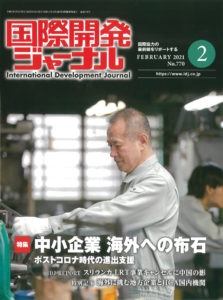IDJ-ENGLISH Construction of hospitals in a transitional period
Special Feature Articles on Healthcare and Medical Cooperation
Construction of hospitals in a transitional period
Mr. Masayoshi Tsumoto,
Manager, Overseas Business Department,
Yamashita Sekkei Inc.
Japan's strengths are experienced knowledge and disaster prevention technology
Japan has two major strengths in hospital cooperation. The first is the accumulation of experience in hospital construction and design. Among developed countries, Japan has an extremely large number of hospitals, especially hospital beds. The number of doctors and nurses is said to be about the same as in the United States. But the number of hospital beds is many times greater. For this reason, specialized teams have experience in the construction and design techniques of large and specialized hospitals (infectious disease control hospitals, epidemiological laboratories, etc.) that require complex and advanced technology.
The second is structural reliability. Japan, a disaster-prone country, has advanced technology in disaster prevention architectural design. Taking advantage of these strengths, it is also possible to provide support through only grant aid to create a base hospital that can continue functioning even in the event of a disaster in a country where there is heightened concern about large-scale disasters.
However, in developing countries, there are many cases where standards for hospital construction are not apt for the introduction of Japanese knowledge and technologies. In some cases, support for the development of guidelines may be effective for the Japan International Cooperation Agency (JICA) to promote hospital cooperation. We would like to support these cases.
The design from a medium- to long-term perspective is also a strength
One of the challenges in the construction of hospitals in the future will be the introduction of environmental technology. This is because hospitals that require 24-hour operations consume significantly more energy than other buildings. So if they are not designed to increase energy efficiency, hospital management will be strained.
For this reason, even in hospitals such as in Vietnam, the hospital rooms with large capacity may be designed to increase the ceiling height and encourage natural ventilation. However, as living standards rise due to economic growth, air conditioners are being introduced in such hospital rooms, and energy efficiency is deteriorating.
And since the windows are closed, it is not good from the viewpoint of preventing the spread infectious diseases within hospitals. It is necessary to introduce energy-saving technology that reduces operating costs while ensuring efficient ventilation.
In addition, hospitals frequently introduce new medical technologies and large medical devices such as MRI, and each time the building needs to be renovated and enlarged. Japanese hospitals are designing for such future changes, but this is often not the case in developing and emerging countries. Another strength of Japan is that it can be designed from a medium- to long-term
Another challenge for the future is the need for a hospital plan that envisions of infectious diseases pandemics in response to the COVID-19 crisis. In Japan, measures are being taken to prevent infection from doorknobs and faucets, such as by separating the doorways and movement lines of medical personnel and patients. The difficulty is that such measures in each country are still being discussed and are just "the best thing to do at the moment." There is a possibility that the way of thinking has changed between the time of the basic design and the time of the detailed design afterwards.
We have to move forward with that in mind, so the construction of the hospital of the future is a fairly challenging. And I feel like we are entering a transitional period.
Still, there are many Japanese companies that challenge meaningful projects, in the belief that "only our own company can do it". We can't afford to ignore earnings, but that's not the primary motivation. That's why I expect JICA to take on challenging projects that can make use of Japan's technological capabilities.
International Development Journal, 2021 January Edition
*****以下、日本語原文*****
特集・再考 日本の保健医療協力
過渡期迎える病院建設
(株)山下設計 国際事業部 部長 津本正芳氏
日本の強みは経験知と防災技術
病院協力における日本の強みは、大きく2つある。第一に、病院建設・設計の経験の蓄積だ。日本は先進国の中でも病院数、特に病床数が極めて多い。医師や看護師の数は米国とほぼ同じだと言われているが、病床数は何倍にもなる。このため複雑かつ高度な技術を必要とする大型病院や専門病院(感染症対策病院、疫学研究所など)の建設・設計技術も、専門チームが経験を重ねている。
第二は、構造的な信頼性だ。災害大国である日本は、防災建築設計において高度な技術を持っている。その強みを活かして、大規模災害の懸念が高い国で災害時においても機能を継続できる拠点病院を作るというのは、無償資金協力だからこそできる支援でもある。ただ、途上国では病院建築に関する基準が日本の知見を導入するには不適切な場合も散見される。国際協力機構(JICA)が病院協力を進めていく上で、ガイドラインの整備支援が効果的となる場合もあるだろう。これらについて当社も支援していきたい。
中長期視点の設計も強み
今後の病院建設における課題の一つには、環境技術の導入がある。というのも、24時間稼働が必要となる病院は他の建物と比べてもエネルギー消費量が極めて大きいため、エネルギー効率を高める設計でないと病院経営を圧迫してしまう。このためベトナムなどの病院でも、大部屋の病室は天井を高くして自然換気を促す設計になっていることがある。だが、経済成長により生活水準が上がる中で、そうした病室にもエアコンの導入が進んでおり、かえってエネルギー効率が悪くなっている。それに窓を閉め切ってしまうので、感染症などの院内感染防止の観点からみても良くない。十分な換気量を確保しながら、運営コストを低減する省エネ技術の導入が必要である。
また病院というのは、新しい医療技術やMRIなど大型医療機器の導入も頻繁で、そのたびに建物の改修や増築が必要になる。日本の病院はそうした将来的な変化も見越して設計しているが、開発途上国や新興国ではそうなっていないことが多い。中長期的な目線に立って設計ができるのも、日本のもう一つの強みだ。今後の課題をもう一つ挙げれば、コロナ禍を受けて、感染症のパンデミックを想定した病院計画が求められることがある。日本では医療従事者と患者の出入り口・動線を分けたり、ドアノブや水栓からの感染を避けるため非接触型にしたりなど対応が進められている。難しいのは、各国でのそうした対策はまだ議論の途中であり、「現時点での最善策」であるという点だ。基本設計の時と、その後の詳細設計の時とでは、考え方が変わっている可能性もある。そういうことも視野に入れながら進めていかないといけないので、今後の病院建設はかなり挑戦的な取り組みであり、過渡期を迎えているように感じる。
それでも、「自分たちの会社にしかできない」といったように、意義が高い案件には、当社も含め挑戦する日本の企業は多い。収益を度外視するわけにはいかないが、それが第一ではない。だからこそ、日本の技術力を生かせる挑戦的な案件をJICAに期待している。
『国際開発ジャーナル』2021年1月号掲載記事
(特集 再考 日本の保健医療協力より)



